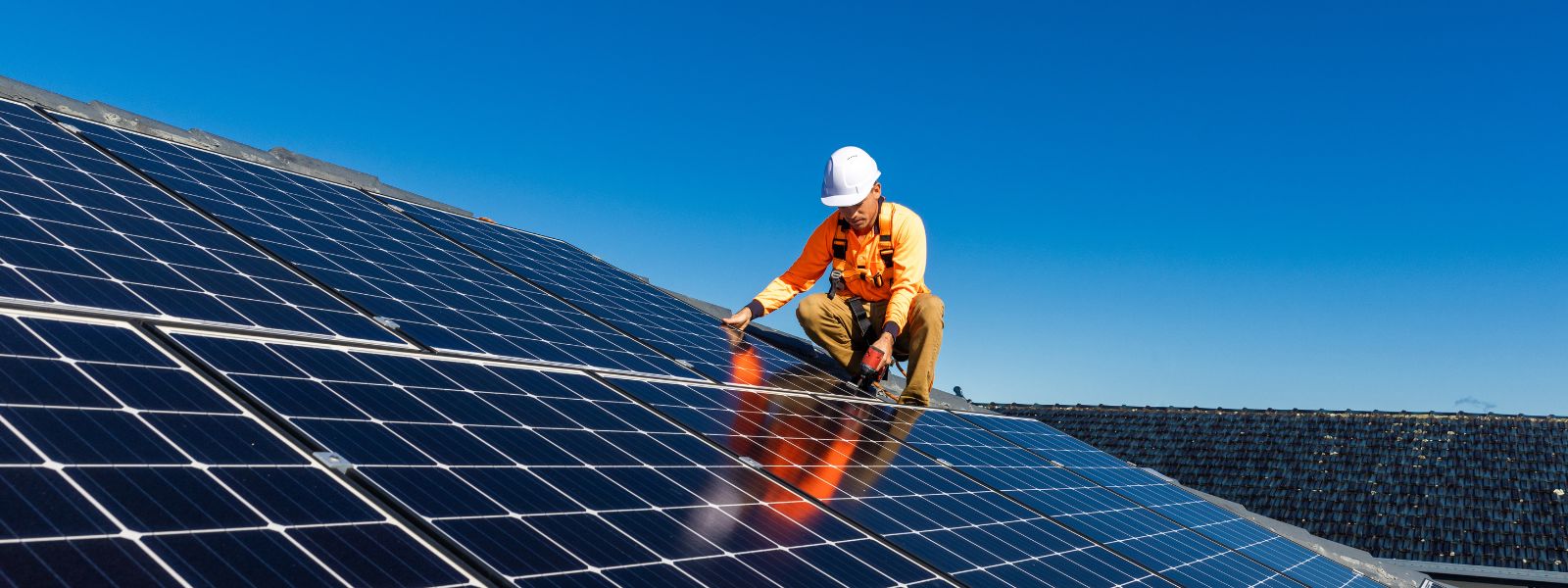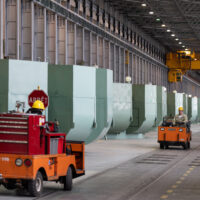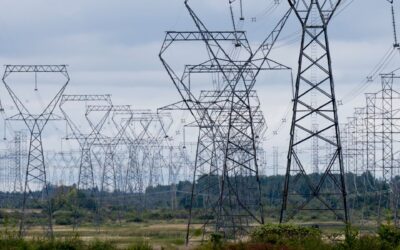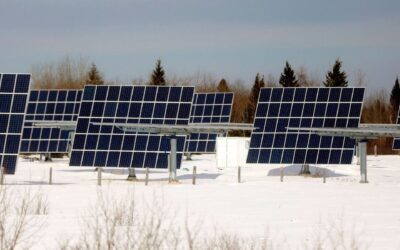Canada’s economy is facing unprecedented challenges: tariffs from our primary trading partner, a wave of protectionist policies in economies around the world, and heightened geopolitical uncertainty. Faced with these economic headwinds, Canadian governments are working to establish new, resilient drivers for Canada’s long-term competitiveness and prosperity.
It might be easy to overlook that, at the same time, the global economy is transforming in other unprecedented ways—some call these changes a revolution—that will forever change the drivers of Canada’s international competitiveness and economic resilience: clean electricity technologies including solar panels, wind turbines and batteries are experiencing drastic cost reductions driven by and further accelerating unseen investment levels in their deployment. Already, two thirds of global capital flowing in the energy sector is going to clean tech—and the trajectory is upward.
This clean energy revolution can create immense, long-term growth opportunities for Canada by opening doors for new trade relationships and enabling significant productivity improvements at home. Achieving leadership in the emerging global clean electricity economy will allow Canada to reconcile its economic, environmental, and security imperatives. But these opportunities require Canadian governments to take urgent and decisive action now.
This post identifies three policy areas where Canadian governments should take action to prepare for these drastic changes and help Canada compete in this new, electrified world.
Falling technology prices drive the global clean electricity boom
Despite recent setbacks on climate policy, most drastically in the U.S. but with reverberations around the world, the global clean energy transition is gaining speed. Energy analysts speak of an electrotech revolution that is shocking global markets and leading to irreversible changes in the way economies generate and use energy.
The source of the shock is not primarily government policy, but prices. Due to economies of scale, solar panels, wind turbines, and batteries are now routinely cheaper to install than new coal or gas plants. Between 2023 and 2024, battery system costs fell by a whopping 40 per cent, and once installed, solar panels and wind turbines have minimal operating costs; they do not require expensive fuels from volatile global markets. They are also much faster to build.
As a result of falling costs of clean energy compared to conventional sources, global investment in clean electricity generation and battery storage is at record-highs. According to the International Energy Agency (IEA), projected investment in clean energy sources will top US$2 trillion in 2025—twice the projected investment in oil, gas, and coal. Global solar installations rose by 64 per cent in the first half of 2025, reaching a capacity of 380 GW, making it the fastest-growing source of electricity generation. Also according to the IEA, battery storage in the power sector was the fastest-growing energy technology in 2023 that was commercially available, with deployment more than doubling year-on-year.
While the vast bulk of clean energy investments occur in China, Canada has seen an uptick—and developers are signalling an appetite for more. Canadian utilities are set to double clean electricity and storage on their grids, and recent procurement rounds for clean power in multiple provinces have been oversubscribed, meaning that developers see more profitable opportunities to invest in low-cost clean power than what utilities are currently asking for.
These trends have two big policy implications for Canada. First, Canada should expand its clean electricity grids to meet ever-growing demand for affordable, reliable power from Canada’s households and industries (see below). Secondly, with Canada’s old and new trading partners rapidly electrifying, Canada risks failing to meet the growing demand for the materials and technologies driving the electrotech revolution.
The clean electricity supply shock and surging electricity demand create a virtuous growth cycle
Low-cost clean power will only accelerate the electrification of industry, households, and transport worldwide. For instance, electric vehicle (EV) sales are soaring: in 2024, every fifth car sold worldwide was an EV and in China, it was every second car. Similarly, global uptake of both residential and industrial heat pumps is soaring, as they can lead to significant efficiency increases in both settings.
In parallel, data centres are emerging as enormous new sources of electricity demand, many with a strong preference for clean power, and their extraordinary strain on existing grids encourages the development of new, innovative agreements where companies act as ‘prosumers’ that agree to shift or modify their consumption patterns to reduce peak demand in return for a lower rate or permission to connect at all.
These global trends are becoming visible in Canada. Projected electricity demand is rising fast in many Canadian provinces including B.C., Quebec, Ontario, and Alberta, often significantly exceeding projected supply—and the supply gap comes at an economic cost. Already industrial users are met with long waitlists for connecting to the grid, which leads to immense opportunity cost in the form of foregone investment in industries with high electricity demand.
On the flipside, a rapid build-out of low-cost clean electricity grids offers immense opportunities for clean growth by meeting the growing industrial demand fast, attracting more industrial investment and at the same time enabling industrial electrification (with the accompanying gains in efficiency).
However, not all jurisdictions will be equally well-equipped to realize these economic opportunities created by the electrotech revolution. Governments failing to act now risk being left behind.
What Canadian governments should do now to prepare the Canadian economy for the electrotech revolution
Canada’s resources put it in an excellent position for becoming a leader in the electrotech revolution. Already the country has some of the world’s lowest-cost electricity, a comparative advantage born of mid-century hydro megaprojects in B.C., Quebec, and Manitoba, which also provide flexibility—invaluable in grids with large shares of renewables. Canada also has significant reserves of the critical minerals that form essential building blocks to many clean energy technologies and a developing battery industry.
Canadian governments should focus a new economic strategy on setting the right conditions for Canada’s sustained, resilient growth and competitiveness in a new global economy run on clean electricity:
- Governments should strengthen and adapt policies and incentives to support the build-out of a competitive clean electricity system to power industrial growth, while maintaining grid reliability and competitive rates.
At the federal level, key policy tools for building Canada’s clean energy economy are already in place, including clean electricity regulations, clean energy investment tax credits, and Canada’s large emitter trading system (LETS) (or industrial carbon price). The federal government should strengthen these policies to provide long-term certainty for investors.
A central task for sub-national governments is to remove barriers for clean power investments, which requires a re-think of the rules that shape provincial electricity systems to ensure they are prepared for the electricity supply and demand shocks outlined above. Energy planning processes, procurement rules, and rate setting policies must enable investment in a large-scale build-out of clean grids (including generation, storage and transmission) and thus facilitate growth in the industries looking for abundant clean power at competitive rates. Jurisdictions not able to meet their demand will experience opportunity costs of foregone industrial investment and activity.
Collectively, Canadian governments should also promote more inter-provincial electricity trade, which will allow for a more efficient use of the diverse clean energy resources across the country.
- Governments should support the electrification of Canadian industry, including steel, cement, mining and the chemical industry, because these investments have positive spillovers for the entire economy.
In addition to strengthening industrial carbon pricing or LETS as a central driver of clean energy investment, Canadian governments should provide strategic, temporary support to industry for electrification. These initial investments in innovative technologies and first-of-kind implementation will realize learning effects and economies of scale that benefit others in the sector and Canada’s economy as a whole.
While technological solutions for electrification readily exist in some industrial sectors, their implementation is typically capital intensive (as is the case for steel). For other sectors (such as chemistry), technologies for electrification are still in development.
LETS is Canada’s most effective policy to curb emissions in industrial sectors and incentivize billions of dollars of investment in cleaner, innovative technologies. Analysis shows that it is good for competitiveness, too: large emitter trading systems have no big impact on companies’ profitability, and the policy allows for a variation in performance benchmarks to address any remaining competitiveness concerns for industries that are both emissions-intense and heavily traded on international markets.
In the long run, industrial electrification will be cheaper and more efficient and productive—a choice that companies would make regardless of emissions restrictions. For example, industrial heat pumps can be three to five times more efficient than traditional boilers, which not only reduces companies’ energy bills but also insulates them from volatile gas prices.
However, in the short term, market failures including learning curves and scale effects can slow private investment in innovative electrification technologies. Governments can support companies with the high upfront cost, because of the positive spillover effects for the rest of the economy resulting from building first-of-kind projects for industrial electrification or developing new technological solutions in that space. Capital markets on their own will not factor these positive economy-wide effects into their investment decisions, and industrial carbon pricing alone is often insufficient to close the financing gap. Blended finance instruments enable governments to unlock private investment in these projects and technologies while minimizing public expenditures. In addition, Canadian governments should support the development of a Canadian climate investment taxonomy to direct more investment in clean electricity infrastructure and industrial electrification to keep Canada’s industries competitive in a changing world.
- Governments should create incentives for investment in Canada’s critical minerals value chain for clean energy technologies.
The world needs more critical minerals to support the clean electricity revolution. Canada has large reserves of essential resources for building electrification hardware: the critical minerals that go into batteries, transmission cables, EV charging stations, etc.
Developing these value chains represents a multi-billion dollar economic opportunity for Canada while strengthening energy security and enabling new trade relationships (for example, in Europe). Seizing the opportunity, however, requires smart policies both at the federal and provincial/territorial level as multiple market and policy failures slow private investment in the sector. Importantly, global critical minerals markets are typically dominated by a few powerful players, which leads to significant market risks for investors due to opaque, volatile prices. Governments should share some of these financial risks with investors to help attract capital at the required scale and pace. Governments should also take action to speed up project development by strengthening Indigenous rights, enabling Indigenous partnerships, and reducing environmental risks.
The electrotech revolution is key to building Canada’s long-term economic resilience and competitiveness—and now is the time to send the right policy signals.
At a time when Canada is looking for new drivers of resilient economic growth and new trade relationships, the global electrotech revolution can create big economic opportunities. Falling costs for clean energy technologies encourage investment in clean energy infrastructure and efficiency-enhancing electrification, while also offering Canada new avenues for achieving leadership in world markets and building new trade relationships.
Canada’s starting position is excellent. The country has the energy resources to build clean, reliable, low-cost electricity grids of the future by enabling the build-out of renewable power, storage, and transmission. Canada also has the critical minerals that are essential for building resilient battery value chains and establishing new trade partnerships.
While effective policies to seize these opportunities are already in place, governments must strengthen and coordinate them to form a coherent strategy that is preparing the Canadian economy for the inevitable and irreversible effects of the global electrotech revolution. The global energy economy is changing drastically, and Canada’s new strategy for long-term economic growth must focus on these changes and prepare the Canadian economy to seize emerging opportunities and make Canada a clean electricity superpower.








